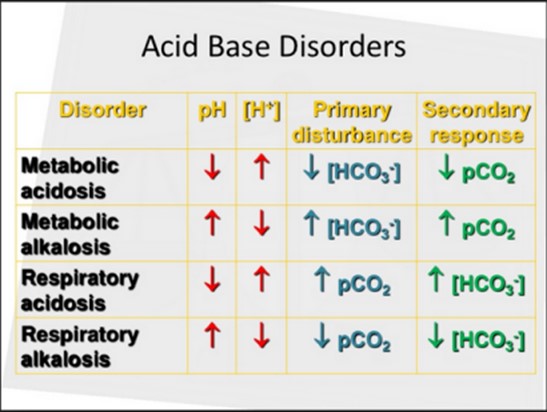Mrs. Kalen is a 70-year-old female who has arrived at the ER due to persistent vomiting for two days now. She appears to be lethargic and weak and has myalgia. She is noted to have dry mucus membranes and her capillary refill takes >4 seconds. She is diagnosed as having gastroenteritis and dehydration. Measurement of arterial blood gas shows pH 7.5, PaO2 85 mm Hg, PaCO2 40 mm Hg, and HCO3 34 mmol/L. Based on the acid-base interruption from Mrs. Kalen, what can the nurse anticipate the treatment will be for correcting this imbalance?
administration of antiemetics
administration of diuretics
Possible Electrolyte replacement if warranted
Administration of IV 0.9 Saline Solution infusion
Have the patient go home and rest. It will resolve itself shortly.
The Correct Answer is D
Mrs. Kalen is diagnosed with gastroenteritis and dehydration, and the arterial blood gas results indicate metabolic alkalosis (elevated pH and HCO3-). This suggests that there is an excessive loss of gastric acid and chloride ions from vomiting, leading to an imbalance of electrolytes and an increase in bicarbonate levels.
To correct the imbalance and treat dehydration, the primary intervention is fluid replacement. Administration of IV 0.9 Saline Solution, also known as normal saline, is commonly used for fluid resuscitation and rehydration. This isotonic solution helps restore fluid balance and electrolyte levels in the body.
Administration of antiemetics may help control vomiting, but the primary treatment focus in this case is fluid and electrolyte replacement to correct dehydration and the associated metabolic alkalosis.
Administration of diuretics, which increase urine output, would not be appropriate in this case as the patient is already experiencing dehydration.
Electrolyte replacement may be necessary if there are specific electrolyte imbalances identified, but the primary treatment is fluid replacement with IV saline solution.
Having the patient go home and rest without addressing the underlying dehydration and metabolic alkalosis would not be appropriate as it can lead to further complications.
Nursing Test Bank
Naxlex Comprehensive Predictor Exams
Related Questions
Correct Answer is C
Explanation
The pH value of 7.5 indicates alkalosis, as it is above the normal range of 7.35-7.45. The elevated bicarbonate (HCO3-) level of 34 mmol/L suggests metabolic alkalosis, as it is higher than the normal range of 22-28 mmol/L. The PaCO2 level of 40 mm Hg falls within the normal range of 35-45 mm Hg.
In this case, the primary disturbance is metabolic alkalosis, which is likely caused by vomiting leading to excessive loss of gastric acid (hydrogen ions) and chloride ions from the stomach. This loss of acid and chloride results in an imbalance of electrolytes and an increase in bicarbonate levels, leading to metabolic alkalosis.
The arterial blood gas results do not indicate any compensation. Compensation occurs when the body attempts to restore the pH balance by adjusting the respiratory or metabolic systems. In this case, there is no compensation observed because the PaCO2 level is within the normal range and not significantly altered.

Correct Answer is ["A","B","D","E","F","G","H","J"]
Explanation
● Weight 98 lbs: This information helps determine the patient's baseline weight and assess for potential weight loss associated with dehydration.
● Dehydrated: The diagnosis of dehydration indicates a critical condition that requires immediate attention and intervention.
● Lethargy: Lethargy suggests a decreased level of consciousness and could indicate a severe state of dehydration or other underlying issues that need to be addressed promptly.
● HR 122: A heart rate of 122 beats per minute is elevated and may indicate compensatory mechanisms in response to dehydration or other underlying conditions. It requires further evaluation and intervention.
● Shortness of Breath: This symptom suggests respiratory distress and may be related to the patient's dehydration or underlying conditions. It requires immediate assessment and intervention.
● Temperature 100: An elevated temperature may indicate an underlying infection or inflammatory response. It requires further evaluation to determine the cause and guide appropriate treatment.
● Thirsty: The patient's report of feeling thirsty is an important symptom indicating dehydration and the need for fluid replacement.
● BP 90/50: A blood pressure of 90/50 is low and may be indicative of hypotension, which can occur in dehydration. It requires close monitoring and intervention to stabilize the patient's blood pressure.
The following items are not immediate concerns based on the given information: ● Admitted to the ER: While it is important information, it is not a current concern as the patient is already in the ER.
● Female: The patient's gender is not an immediate concern for the assessment and management of dehydration.
Whether you are a student looking to ace your exams or a practicing nurse seeking to enhance your expertise , our nursing education contents will empower you with the confidence and competence to make a difference in the lives of patients and become a respected leader in the healthcare field.
Visit Naxlex, invest in your future and unlock endless possibilities with our unparalleled nursing education contents today
Report Wrong Answer on the Current Question
Do you disagree with the answer? If yes, what is your expected answer? Explain.
Kindly be descriptive with the issue you are facing.
